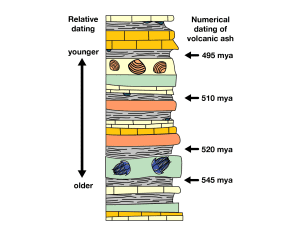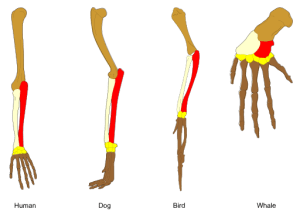
Unit 7.6: Evidence of Evolution
Introduction to Evolution: Unveiling the Evidence
Evolution is more than just a theory – it’s a comprehensive explanation backed by evidence from various scientific disciplines. From fossil records to DNA sequences, the proof of evolution is robust and consistent, offering a window into how life on Earth has changed over time. Here are the key pieces of evidence that support the theory of evolution.
Table of Contents
Toggle1. Fossil Evidence: The Chronicles of Ancient Life
Fossils provide a historical record of life on Earth, capturing snapshots of organisms from millions of years ago. By comparing fossils from different geological layers, scientists have uncovered how species have gradually changed over time, revealing transitional forms that bridge evolutionary gaps between modern and ancient species.
How Do Scientists Date Fossils?
Dating fossils isn’t guesswork – scientists use advanced techniques such as:
Stratigraphy: Analyzing the layers of rock to determine a fossil’s relative age.
Radiometric Dating: Measuring the decay of isotopes like carbon-14 or potassium-argon to determine precise ages.
Paleomagnetism: Studying the alignment of magnetic minerals in rocks to determine the age based on changes in Earth’s magnetic field.
Tephrochronology: Using volcanic ash layers with unique chemical signatures to correlate and date different fossil sites.
These methods allow paleontologists to accurately reconstruct the history of life, providing compelling evidence for the gradual evolution of species.
2. Comparative Anatomy: Vestigial and Homologous Structures
Evolution leaves its footprints in the anatomy of living organisms. One type of evidence is vestigial structures, which are remnants of features that served important functions in an organism’s ancestors but are no longer useful today.
Examples of Vestigial Structures:
Human Appendix: Once likely used to aid in digesting plant matter, now has minimal function.
Wisdom Teeth: Third molars that were helpful to early humans with tougher diets but now often cause problems.
Human Tailbone: The coccyx is a remnant of a tail, which served a purpose for our primate ancestors.
Wings on Flightless Birds: Penguins and ostriches still have wings, though they are no longer used for flight, but may serve other purposes like balance or thermoregulation.
These structures offer clear evidence of an evolutionary past that has shaped the anatomy of modern species.

Homologous Structures: These are anatomical features found in different species that have similar structures but may serve different functions, indicating a common ancestor. For instance:
The forelimbs of humans, dogs, birds, and whales have similar bone structures (humerus, radius, ulna), even though they are adapted for very different purposes like grabbing, walking, flying, or swimming.
The similarity in the underlying structure suggests these species all descended from a common ancestor with a similar limb structure.
3. Biochemistry and Molecular Biology: Genetic Evidence of Evolution
The strongest and most compelling evidence for evolution comes from molecular biology – specifically, the study of DNA and proteins.
Universal Genetic Code: All living organisms use the same genetic code, which points to a shared common ancestry.
Comparative DNA Sequences: By comparing DNA sequences, scientists can determine how closely related different species are. Species with a high degree of similarity in their DNA are believed to have diverged from a common ancestor more recently.
Proteins and Enzymes: The similarity in protein structures and enzymes across diverse species also provides evidence for a shared evolutionary past.

4. Biogeography: Distribution of Species Across the Globe
The geographic distribution of species gives important clues about their evolutionary history.
Related Species in Close Proximity: Similar species are often found in geographically close areas. For example, marsupials like kangaroos and koalas are almost exclusively found in Australia, suggesting they evolved after becoming geographically isolated.
Different Species in Similar Environments: Organisms that aren’t closely related may evolve similar traits due to similar environmental pressures. This is known as convergent evolution.
5. Mathematical Modeling: Quantitative Evidence of Evolution
Mathematical models allow scientists to simulate the processes of evolution and predict genetic and phenotypic changes over generations. Models like the Hardy-Weinberg equilibrium can help estimate whether evolution is occurring in a population and help quantify changes in allele frequencies. This quantitative evidence, when validated by observational data, strengthens the case for the theory of evolution.
The Importance of Fossils and Living Species
Fossil records and vestigial structures together provide compelling visual and physical evidence for evolutionary change over time. By studying the fossils of ancient species, scientists have documented numerous examples of transitional forms that show the gradual changes leading to modern species.
Living species, like today’s whales and birds, show physical remnants of evolutionary change. For instance, whales retain small, internal vestiges of hind limbs, highlighting their descent from four-legged ancestors.
Conclusion: Evidence That Unites All Life
The theory of evolution, supported by a wealth of evidence across disciplines, offers the most comprehensive explanation for the diversity of life on Earth. From fossils to DNA, all life forms share a common history, illustrating the beauty and interconnectedness of all living organisms. By understanding this shared history, we can better appreciate the complexity of life and the mechanisms that continue to shape the natural world.
Recent Posts
- Laws of Indices – Number & Algebra – IB Mathematics AA HL
- Standard Form – Number & Algebra – IB Mathematics AA HL
- 9.2 Crafting an argument through stylistic choices like word choice and description
- 9.1 Strategically conceding, rebutting, or refuting information
- Unit 9 Overview: Developing a Complex Argument
- 8.4 Considering how style affects an argument
- 8.3 Considering how all choices made in an argument affect the audience
- 8.2 Considering how sentence development and word choice affect how the writer is perceived by an audience
- 8.1 Choosing comparisons based on an audience
- Unit 8 Overview: Stylistic Choices
- 7.4 Exploring how sentence development affects an argument
- Syllabus
- Study Guides for every class
- Short Notes
- 7.3 Examining how counterargument or alternative perspectives affect an argument
Choose Topic
- ACT (17)
- AP (20)
- AP Art and Design (5)
- AP Physics 1 (1)
- AQA (5)
- Artificial intelligence (AI) (2)
- Banking and Finance (6)
- Biology (13)
- Business Ideas (68)
- Calculator (72)
- ChatGPT (1)
- Chemistry (3)
- Colleges Rankings (48)
- Computer Science (4)
- Conversion Tools (136)
- Cosmetic Procedures (50)
- Cryptocurrency (49)
- Digital SAT (3)
- Edexcel (4)
- English (1)
- Environmental Science (2)
- Exam Updates (1)
- Finance (17)
- Fitness & Wellness (164)
- Free Learning Resources (209)
- GCSE (1)
- General Guides (40)
- Health (107)
- History and Social Sciences (152)
- IB (1)
- IGCSE (2)
- Image Converters (3)
- IMF (10)
- Math (39)
- Mental Health (58)
- News (8)
- OCR (3)
- Past Papers (463)
- Physics (5)
- SAT (39)
- Schools (3)
- Sciences (1)
- Short Notes (5)
- Study Guides (28)
- Syllabus (19)
- Tools (1)
- Tutoring (1)

